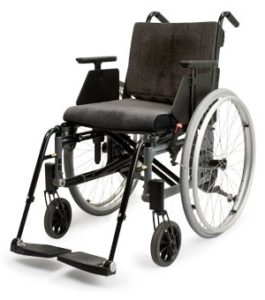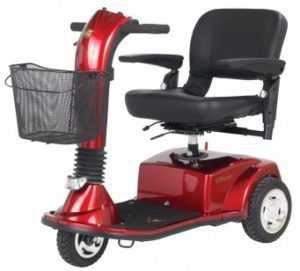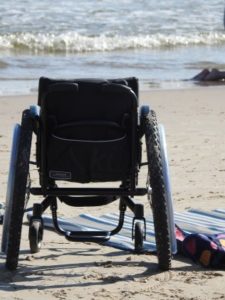Author: Sharon Jang | Reviewer: Emma M. Smith | Published: 25 March 2020 | Updated: ~
Wheeled mobility devices like wheelchairs and scooters are an important part of independent living after spinal cord injury (SCI). This page provides an overview of the basics of the provision process and choosing a wheeled mobility device after SCI.
Key Points
- Wheeled mobility devices such as wheelchairs and scooters are used to enhance mobility and independence for people with paralysis, weakness, or sensory loss resulting from an SCI.
- There are many factors that play into device selection and set-up including the goal of the user, personal factors, and environmental factors.
- The World Health Organization has outlined an 8-step wheelchair provision process to help ensure a smooth and successful transition into a using a new wheelchair.
Wheeled mobility devices are assistive technologies that are used to enhance mobility and independence following SCI. This may include a range of different wheeled devices, including manual wheelchairs, power wheelchairs and scooters.

Wheeled mobility devices are an important part of daily life for many people after SCI. They are used primarily to assist people with reduced mobility caused by weakness, paralysis, or loss of sensation, which can make it more difficult to move around independently. These devices assist individuals to move around and access their environment and community, which is an important part of being able to participate fully in life, including tasks of everyday living, work, social life, and recreation.
The main types of wheeled mobility devices typically used by people with SCI are manual wheelchairs and power wheelchairs; though there are also other options. The type of device is selected based on your physical abilities, needs, preferences, and available funding.
Manual wheelchairs

Manual wheelchairs are propelled by the user or pushed by another person. They do not typically have a battery or other power source. Manual wheelchairs are usually used by people who have enough muscle control and strength in the arms to propel the wheelchair forward on their own.
Refer to our article on Manual Wheelchairs for more information!
Power wheelchairs

Power wheelchairs are electrically powered devices that can be controlled by the user or another person. Depending on the level of movement control, they can be controlled by the hand, head, breath, or other specialized controls. Power wheelchairs are an alternative to manual wheelchairs and may be used when someone has limited arm control or strength, concerns with fatigue, pain, or injuries limiting their ability to propel a manual wheelchair, or a preference for powered mobility.
Refer to our article on Powered Mobility Devices for more information!
Other Devices

In addition to the many different types of wheelchairs that are available, there are several other power wheeled mobility devices such as mobility scooters and even Segways, which may be used in other circumstances, such as for people who are able to walk to some extent, but not for long periods of time.
Selecting a wheeled mobility device usually involves working together with your health team to find a device that fits best with your body, physical abilities, preferences, and lifestyle. Your source of funding is also an important factor, because mobility devices are often very expensive.
Your health team
Choosing a mobility device may involve working with several different health providers, which may include: occupational therapists, physiotherapists, equipment/assistive technology specialists, physicians, and sometimes equipment vendors like Durable Medical Equipment (DME) providers (people who sell medical equipment).
Assessment
A health history, physical examination, and interview will be completed to determine your functional abilities, wheelchair fit, and which device is most suitable for you. This will typically involve asking you questions about your health history, and lifestyle. In addition, your physical abilities and posture and alignment may be evaluated to determine which equipment will best suit your needs. Assessments may also involve special technologies for seating assessment, such as pressure mapping.
Refer to our article on Pressure Mapping for more information!
Factors to be considered
A wide range of factors must be considered when selecting a wheeled mobility device to ensure that it is safe and meets your needs. These factors may include:
Physical considerations
Physical considerations include your functional abilities (e.g., amount of arm/trunk control, strength, range of motion), body measurements (e.g., weight, height, and joint positioning).
Time since injury
Your potential for recovery, such as how long it has been since the injury and whether you are continuing to see improvements in function.
Medical considerations

The activities you wish to do in your wheelchair influence the selection of your wheeled mobility device. 6
Other medical conditions that may affect your movement, positioning, and wheelchair use, including pressure injuries, spasticity, shoulder injuries, and pain.
Lifestyle considerations
Lifestyle considerations include how much time you will be spending in the chair each day, what activities you will be doing in your chair, whether you will need to get the chair in or out of your car, or if you will be using the chair for sport.
Environmental considerations
Your home and work environment need to be considered in regards to what kind of mobility device is best for you. Some considerations include whether the location is carpeted, obstacles and barriers in the built environment, and the amount of space available for you to maneuver in.
Caregiver considerations
Will other people in your life who may provide assistance to you, such as paid caregivers, family members, or health providers be helping you push the mobility device? Will they help with folding it up?
Funding considerations
Your funding, such as whether you have medical coverage and insurance to reimburse the costs of equipment.
Your personal preference
It is also important to consider your preferences in device selection!
Your mobility needs may change over timeIt is important to consider that your mobility needs may change over time. For example, changes that affect your functional status, the development of new medical conditions or the development of new technologies may result in a need to reassess your changing needs over time. Regular check-ins with your health team are an important part to take into consideration how your needs may change over time. |
Wheelchair prescription and set-up is an important part of fitting a wheelchair appropriately. This requires consideration of several different factors. The configuration of the wheelchair will greatly affect the overall performance of the wheelchair in the community, as well as how a person functions in the wheelchair. Set-up is also important because complications may arise when inappropriate adjustments/selections are made. Choosing the right device is an important part of making sure that your day-to-day mobility is safe and meets your needs.
It impacts your safety and the prevention of health problems
The characteristics of your mobility device can impact your health in several ways. Ill-fitting or inappropriate equipment can contribute to health problems, such as:
- Pressure injuries from rubbing, friction or areas of high pressure
- Overuse injuries from poor positioning or too much resistance
- Arm, shoulder, or back pain
- Joint contractures or spasticity from poor positioning
- Muscle imbalances or spinal deformities
- Postural changes
- Discomfort
Your device and how it is set-up can also affect your safety. For example, if a chair is set-up in a manner that makes it easy to tip over, it may lead to falls.
It impacts your mobility and everyday function
 The characteristics of your mobility device can also affect how you function in day-to-day life. For example, small tweaks to your wheelchair set-up can make it easier or more difficult to maneuver and propel yourself. The characteristics of your device may also affect the environments and situations that you can use it in, such as whether it can be used outside, during sports, or can be put in and out of a car independently.
The characteristics of your mobility device can also affect how you function in day-to-day life. For example, small tweaks to your wheelchair set-up can make it easier or more difficult to maneuver and propel yourself. The characteristics of your device may also affect the environments and situations that you can use it in, such as whether it can be used outside, during sports, or can be put in and out of a car independently.
It affects your participation in a number of different activities and environments
 There are a variety of styles of wheelchairs and scooters, each with their own benefits and drawbacks. Properties of various mobility devices, such as the turning radius, the length and width, and the stability of the device may impact the types of activities that a wheelchair user can participate in. For example, a wheelchair that has a wide turning radius may not be able to maneuver in smaller stores with narrow aisles. Additionally, some devices perform better in inclement weather than others. This may be a consideration for individuals living in areas where it is often rains or snows.
There are a variety of styles of wheelchairs and scooters, each with their own benefits and drawbacks. Properties of various mobility devices, such as the turning radius, the length and width, and the stability of the device may impact the types of activities that a wheelchair user can participate in. For example, a wheelchair that has a wide turning radius may not be able to maneuver in smaller stores with narrow aisles. Additionally, some devices perform better in inclement weather than others. This may be a consideration for individuals living in areas where it is often rains or snows.
The process of selection is a complicated process that typically involves collaboration among people with spinal cord injury, their caregivers, device prescribers (Occupational Therapists or Physical Therapists), and vendors (sometimes referred to as DME Provider or Durable Medical Equipment Provider). The World Health Organization (WHO) identifies and breaks down this complicated process into 8 important steps. These include:
1. Referral and appointment
In the first step, you will be referred to a knowledgeable health provider. The referral process varies based on the services provided by each country. Some countries may have a self-referral process, while others may require a referral to a wheelchair/mobility device service.
2. Assessment
In this step, you will be accurately assessed to determine the most appropriate wheelchair and wheelchair components for you. Factors that are evaluated during an assessment include: physical functioning, posture, lifestyle/the environment it will be used in, and the tasks that are to be performed using the wheelchair.
3. Prescription
The prescription of a device that best matches the needs of the user then occurs. A vendor or therapist will work with you to choose the right wheelchair, cushion, and parts, and note down the many details and measurements of your wheelchair. In this step, you are encouraged to try various devices and seating set ups with a clinician or vendor to determine what is the most optimal set up for you.
4. Funding and Ordering
Once a detailed prescription has been created, it is then possible to determine an accurate quote for the cost of the wheelchair. A request for funding to the appropriate source with a letter of justification is provided by the prescribing therapist and physician. Determining a source of funding should be in place prior to ordering the wheelchair. Once that has been processed and approved the vendor/DME provider can order the equipment.
5. Product preparation or initial set-up
When the equipment arrives, it will be set-up and put together for the initial fitting as prescribed by the clinician. In addition, the wheelchair is inspected to ensure that it is safe and ready for use. This step is typically completed by the vendor/DME provider.
6. Fitting and adjusting

Getting your wheelchair fitted is important to make sure your chair is suited to your needs. 10
The therapist and/or the vendor will make an appointment to check on the wheelchair to ensure that it has been properly assembled. During this time, they will also make final adjustments so that it fits properly. Some things that are checked during this step include:
- Making sure the wheelchair is the right size
- Ensuring that the wheelchair is properly adjusted to your needs so that secondary complications are prevented
- Confirming that any modifications made are fitting correctly.
7. User training
In this step, you will receive instructions on how to care for your wheelchair and training on wheelchair skills. This step allows you to use your device to its greatest potential, and to receive the most benefits from the device. Some key areas that should be covered in training include:
- How to transfer in and out of your wheelchair
- How to handle the wheelchair
- Basic skills to use your wheelchair
- How to prevent and watch for pressure sores
- How to care for the wheelchair and seating components (e.g., cushion, backrest, etc.)
- What to do if there is a problem.
8. Follow-up, maintenance and repairs
Follow-up is often required to fine tune the set up once the equipment has been used in a variety of environments. During follow-up sessions, the effectiveness of the wheelchair will be evaluated to maximize functioning, comfort, stability, and to make sure that the equipment has been properly maintained. There is no general guideline for how often a follow-up should occur; however, follow-ups and maintenance are beneficial and can contribute to the safe use of your device.
Read our article on Wheelchair Maintenance for more information.
There are many types of wheeled mobility devices that can help you get around after a spinal cord injury. Determining which device will best suit your needs is dependent on a variety of factors. These factors are often considered in partnership with a device prescriber (such as an occupational or physical therapist), who will also help ensure your device properly fits your body and needs.
For a review of how we assess evidence at SCIRE Community and advice on making decisions, please see SCIRE Community Evidence.
Titus L, Moir S, Casalino A, McIntyre A, Connolly S, Mortenson B, Guilbalt L, Miles S, Trenholm K, Benton B, Regan M. (2016). Wheeled Mobility and Seating Equipment Following Spinal Cord Injury. In Eng JJ, Teasell RW, Miller WC, Wolfe DL, Townson AF, Hsieh JTC, Connolly SJ, Loh E, McIntyre A, Querée M, editors. Spinal Cord Injury Rehabilitation Evidence. Version 6.0: p 1-178.
Available from: https://scireproject.com/evidence/rehabilitation-evidence/wheeled-mobility-and-seating-equipment/
Armstrong, W., Borg, J., Krizack, M., Lindsley, A., Mines, K., Pearlman, J., … Sheldon, S. (2008). Guidelines on the provision of manual wheelchairs in less resourced settings. World Health Organization. https://doi.org/10.1007/978-1-349-13869-2_70
Frost, S., Mines, K., Noon, J., Scheffler, E., & Jackson-Stoeckle, R. (2012). Wheelchair service training package: Reference manual for participants. World Health Organization.
Mortenson, W. Ben, & Miller, W. C. (2008). The Wheelchair Procurement Process: Perspectives of Clients and Prescribers. Canadian Journap of Occupational Therapy, 75(3), 167–175.
Rehabilitation Engineering and Assistive Technology Society of North America (RESNA). (2011). Wheelchair service provision guide. Retreived from: https://resna.org/sites/default/files/legacy/resources/position-papers/RESNAWheelchairServiceProvisionGuide.pdf
Image credits:
- Image by the SCIRE Community Team
- Wheelchair etac cross ©Etac Sverige AB, CC BY-SA 3.0
- Pride Jazzy Select power chair ©Stephen B Calvert Clariosophic, CC BY-SA 3.0
- Welland Transportation ©Zdlpwebb, CC BY-SA 4.0
- Rehabilitation equipment ©satynek, Pixabay License
- Modifed from: wheelchair ©Saeful Muslim, CC BY 3.0 US
- Toillet ©Hadi, CC BY 3.0 US
- praying ©Hadi, CC BY 3.0 US
- Image by the SCIRE Community Team
- Image by the SCIRE Community Team







